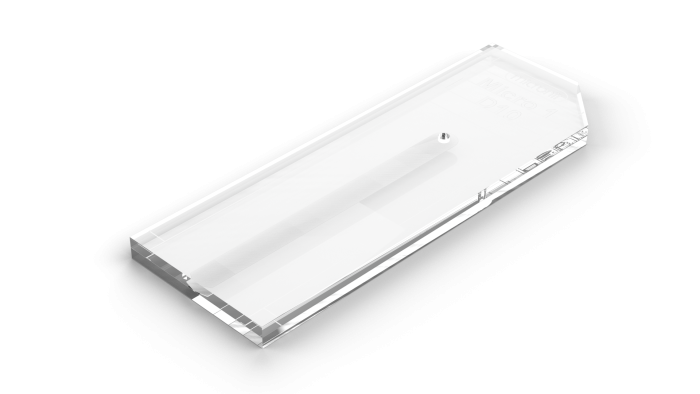Converging nozzle
per pack of 10
Pack of 10 chips to create a liquid sheet, using a converging nozzle.
Application
This converging nozzle chips creates very thin sheets of liquid. Advantage of a thin sheet of liquid is that less molecules of interest are on the same surface which allows close examination of a single molecule. Often the converging nozzles are used on a detection station of a Synchrotron Radiation Light source (accelerator) or in combination with high power laser light sources.
Difference compared to the sheet nozzles
The where developed as gas accelerated nozzles. However, it was discovered that those sheet nozzles did also work in colliding jet mode, where gas is replaced with liquid. In this case two jets of liquids hit each other creating the liquid sheet. The converging nozzles are specifically developed as alternative for use of the sheet nozzles in colliding jets mode. With converging nozzle, there's no need for coating and the converging nozzles can operate for a longer period maintaining stability. Especially high energy laser systems create very demanding circumstances for the coating which can lead to damage/wear of the coating, converging nozzles will be a good alternative in those cases.
Available products
There are currently three versions available with a different nozzle widths and for the large nozzle also a diferent jet angle.
| SKU | Name | Nozzle width | Nozzle height | Jet angle |
| 11003384 | Micro 2 | 100µm | 10µm | 30 degrees |
| 11003383 | Micro 2N | 100µm | 10µm | 50 degrees |
Interfacing
Sheet and converging nozzles both use the same interfacing concept, that is not compatible with other products in the store. Micronit can bring you in contact with a third party that can supply a compatible interfacing tool.
| Unit of measurement | pack of 10 |
|---|---|
| Interface type | Topconnect - product specific |
| Details for interfacing | This product require an interfacing tool supplied by a third party, see Product Questions for details. |
| Chip material | Borosilicate glass |
| Coating | No coating (hydrophilic) |
| Icon | Label | Description | Type | Size | Download |
|---|---|---|---|---|---|
 | 11003384 - Drawing | Technical drawing for converging sheet nozzle Micro 2 | 97 KB | Download | |
 | 11003383 - Drawing | Technical drawing for converging sheet nozzle Micro 2N | 95.8 KB | Download | |
 | Converging nozzles - How to use | This guide will explain how a setup using the converging nozzles can look like and how a liquid sheet can be created. | 1022 KB | Download |

